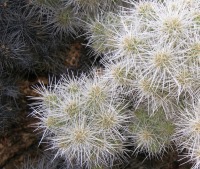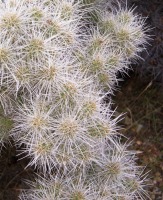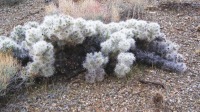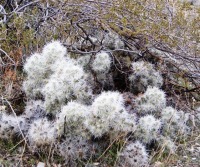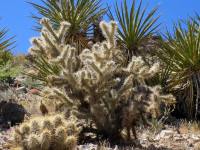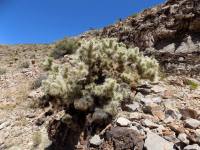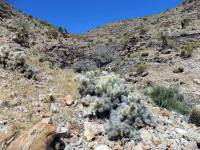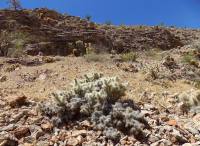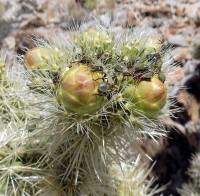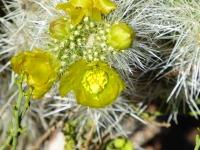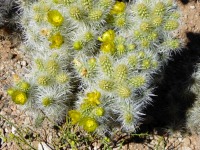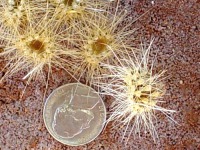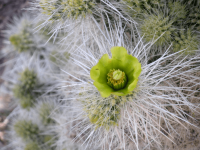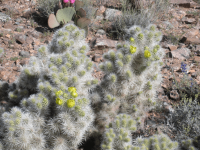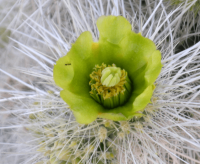Clokey. Madroño (Journal of the California Botanical Society) 7: 69 1943.
Herbarium specimen; Herbarium specimen; Herbarium specimen; Herbarium specimen; Herbarium specimen
Original description
Treatment by Baker, 2005
What is Cylindropuntia multigeniculata?
Cylindropuntia multigeniculata is a rare cholla occurring in the northeastern Mojave desert in southern Nevada and northwestern Arizona. It occurs sporadically in rocky limestone, basalt, granite, and rhyolite substrates between 1035 to 1400 m elevation.
Details
G. multigeniculata is a sprawling to erect dense and compact shrub usually growing to approximately 0.5 m tall. The stems are fairly firmly attached and range from 3 to 5 cm long by 1 to 2 cm wide. Each areole has 4 to 24 thin white spines, which almost or entirely obscure the stem. The sheaths are also thin and white or silver, though they are sometimes pink-tinged in the northernmost populations. The flowers are greenish-yellow with cream to pale yellow filaments, styles, and stigmas. The fruits are leathery, yellow, and range from almost completely spineless in some populations to consistently spiny in others. Fruit spininess appears to follow a geographical cline, with populations in the northwestern end of the species range having essentially spineless fruits and those in the southeast end of its range having the spiniest fruits. G. multigeniculata is diploid (2n = 22).
Putative hybrids of G. multigeniculata and G. acanthocarpa var. acanthocarpa at the type locality of G. multigeniculata (Blue Diamond, Nevada) bear a strong resemblance to G. echinocarpa, suggesting a possible hybrid origin of the widespread and morphologically variable G. echinocarpa. However, recent data demonstrates that G. multigeniculata is not of hybrid origin. G. multigeniculata also hybridizes with G. whipplei var. whipplei in the Sheep Range of southern Nevada.
The taxonomy of G. multigeniculata has been confused over the years. Clokey correctly considered it a distinct species when he designated it as Opuntia multigeniculata in 1943. In 1982, Benson incorrectly placed it as a variety of Opuntia (Cylindropuntia) whipplei. Because spiny-fruited populations at the southeast end of its range were placed under G. echinocarpa, and because of some morphological intermediacy between G. echinocarpa and G. whipplei, Pinkava considered G. multigeniculata to be a hybrid between these two species. However, a great deal of morphological measurements and statistical analyses quite clearly show that G. multigeniculata is distinct from both G. echinocarpa and G. whipplei. The State of Nevada Department of Conservation & Natural Resources commissioned a report on G. multigeniculata in 2005.
